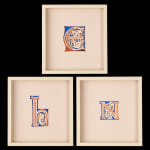Tuscan illuminator (active in Tuscany, 12th century)
Three colorful illuminated initials "E", "H", and "N", from the same gigantic Bible, c. 1175
Tempera and ink on parchment
Initial "E": 58 x 69 mm; initial "H": 85 x 50 mm; initial "N": 49 x 50 mm (framed individually: 18.9 x 18 cm each)
Copyright La Gabrielle Fine Arts SA
CHF 6'250.-
Further images
Coming from the renowned collection of Robert McCarthy and originating from a special type of Bible called 'Bibbie Atlantiche' (in reference to the mythical creature that supported the sky) or...
Coming from the renowned collection of Robert McCarthy and originating from a special type of Bible called 'Bibbie Atlantiche' (in reference to the mythical creature that supported the sky) or 'Atlantic Bible' (in reference to the size of the Atlantic Ocean) because of its enormous size, the three present initials "E", "H" and "N" are richly illuminated. Decorated with complex and intricate geometric patterns, their design is based on the later Geometric style, a style that refers to the ancient Greek art, particularly in pottery. Each initial is adorned with several segments of various shapes, which are themselves decorated with geometric patterns in red, blue or green. The empty space is filled with vine stems or vine stems combined with acanthus leaves that intertwine and blend with the geometric shapes that from the initial.
As developed by Prof. Gaudenz Freuler, these stylistic elements indicate that the Bible from which these three initials originate was probably created in Tuscany, Italy, during the last quarter of the 12th century. A relevant comparison can be made with the decorated initials of an Atlantic Bible now preserved in Siena (Biblioteca Comunale degli Intronati, MS. F.I.5). Moreover, it is possible that our three initials come from an Atlantic Bible that was realized in a scriptorium that is also responsible for another Atlantic Bible, today known though two illuminated leaves and one cutting (Robert McCarthy collection, MS BM 1329, 1330 & 1446). However, these fragments may actually be extracted from the same Bible as our initials. In this case, the scriptorium is only known through the fragments of one Atlantic Bible, the Bible from which our the initials come.
SISTER LEAVES
Six initials "N", "S", "V", "O", "I" and "V": London, Robert McCarthy collection.
Probably, several fragments from the McCarthy collection (The McCarthy Collection. Vol. 1: Italian and Byzantine Miniatures, London, 2018, n° 12 [two leaves and one cutting], 15 [four initials], maybe 16 [five initials]) come from the same Atlantic Bible.
It is possible that seven decorated initials sold c. 1985 (London, Maggs Bros LTD, catalogue 1059: Papyrus to Paper: Papyri, illuminated initials and leaves, paleographical specimens, Books of Hours and other manuscripts [undated, c. 1985]) come from the same Atlantic Bible.
We thank Peter Kidd for suggesting that n°12, 15 and maybe 16 from the McCarthy collection could be sister leaves.
As developed by Prof. Gaudenz Freuler, these stylistic elements indicate that the Bible from which these three initials originate was probably created in Tuscany, Italy, during the last quarter of the 12th century. A relevant comparison can be made with the decorated initials of an Atlantic Bible now preserved in Siena (Biblioteca Comunale degli Intronati, MS. F.I.5). Moreover, it is possible that our three initials come from an Atlantic Bible that was realized in a scriptorium that is also responsible for another Atlantic Bible, today known though two illuminated leaves and one cutting (Robert McCarthy collection, MS BM 1329, 1330 & 1446). However, these fragments may actually be extracted from the same Bible as our initials. In this case, the scriptorium is only known through the fragments of one Atlantic Bible, the Bible from which our the initials come.
SISTER LEAVES
Six initials "N", "S", "V", "O", "I" and "V": London, Robert McCarthy collection.
Probably, several fragments from the McCarthy collection (The McCarthy Collection. Vol. 1: Italian and Byzantine Miniatures, London, 2018, n° 12 [two leaves and one cutting], 15 [four initials], maybe 16 [five initials]) come from the same Atlantic Bible.
It is possible that seven decorated initials sold c. 1985 (London, Maggs Bros LTD, catalogue 1059: Papyrus to Paper: Papyri, illuminated initials and leaves, paleographical specimens, Books of Hours and other manuscripts [undated, c. 1985]) come from the same Atlantic Bible.
We thank Peter Kidd for suggesting that n°12, 15 and maybe 16 from the McCarthy collection could be sister leaves.
Provenance
Part of a gigantic Bible (so-called "Bibbie Atlantiche" or "Atlantic Bible") executed in Italy, Tuscany, c. 1175, by an anonymous illuminator active in Tuscany and for an anonymous donor. If the decorated initials sold c. 1985 by Maggs Bros are from the same Atlantic Bible, then it must have been dismembered before c. 1985. If not, the provenance of the nine known initials from this Atlantic Bible is as follows:London, Phillips, December 3, 1997, part of lot 157 (nine initials)
London, Robert McCarthy collection, MS BM 1147 (nine initials).
Chicago, Freeman's | Hindman, June 27, 2024, lot 4 (three initials as "Italian Romanesque artist").
Literature
PUBLISHED ING. Freuler, The McCarthy Collection. Vol. I: Italian and Byzantine Miniatures, 2018, p. 40-42, n° 13.







